Welcome to Kosovo, Europe’s newest independent state, the final chapter in the dissolution of the Yugoslav state. Kosovo offers its visitors the possibility to feel part of its development in a fast changing environment. This tour aims to show what makes Kosovo a complex yet very special place to be, through visits of its: troubled ancient and modern history, rich culture, stunning nature, numerous religions monuments and friendly people.
Location: Kosovo
Duration: 6 days
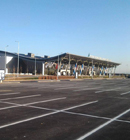
We welcome you at Pristina Airport and transfer to Prizren one of the most beautiful towns in Kosovo where we will overnight for 2 nights. Overnight in Prizren.
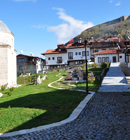
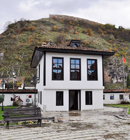
Prizren the second largest in the country is a beautiful city situated in southern Kosovo close to the border with Albania. It is a historic city known for the arts and crafts, something which becomes obvious as soon as you approach the town centre. The cobble stone streets are beautifully crafted as are the shops, bars and restaurants built in a typical Ottoman architecture. It offers some great religious monuments representing different faiths, with the 14th century Orthodox Church of “Our Lady of Ljevis” possibly being the most important a part of the UNESCO list of protected Medieval Monuments of Kosovo. Other monuments we will visit include: the Stone Bridge, bazaar, the Sinan Pasha Mosque built in 1615, Fortress of Prizren and near it the Church of the Holy Saviour, Church of St. George, the Cathedral of Our Lady of Perpetual Succour (Prizren's main Catholic church from 1870). We continue visiting the Museum dedicated to the League of Prizren an Albanian political organization founded on January 5, 1877 taking official form on June 18, 1878. The League’s main scope was the protection of the rights of the Albanian nation during the breakup of the Ottoman Empire. It was a crucial step in raising Albanian national awareness, and paving the way to Albania’s Independence in 1912. Overnight in Prizren.
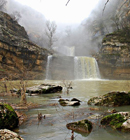
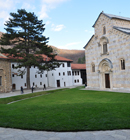
After breakfast ahead lays a great day of discovery of some of Kosovo’s most important monuments. We start with a visit at the “Bodrumi i Vjeter” winery for a tour of Kosovo’s oldest winery and a taste of some of its best wines. Afterwards proceed to the beautiful Mirusha waterfalls for a peak at Kosovo’s wonderful natural landscape. Next is the Monastery complex of Decani considered the largest medieval church in the Balkans containing the most extensive beautifully preserved fresco decorations, deservingly becoming part of UNESCO. The monastery was constructed by Serbian king Stefan Urosh buried in the chapel and completed by his son Stefan Dushan in 1335. The catholicon has striking similarities to a roman catholic church made by its Franciscan monk architect, Fra Vita, from the Montenegrin town of Kotor heavily influenced by Venice architectural style. After the visit proceed to Gjakova which comes next, has a Grand Bazaar thought to be the oldest in Kosovo also known as Ҫarshi, full of old houses & shops, a Turkish Bathhouse or Hamam and the 16th century Hadum Aga Mosque. Overnight in Gjakova in the old quarter.
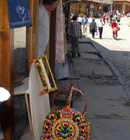
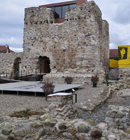
After early breakfast continue to visit another very important religious complex, the Patriarchate of Peja constructed in the XIII century. It is composed of three small churches with beautiful frescoes. For its architectural and cultural values it represents, is part of the UNESCO protected Medieval Monuments of Kosovo. After visiting the complex we continue on to Vushtrri to visit the old castle in the middle of town and the old Stone Bridge. Kosovo has been for centuries a land of contrasts something which has been reflected in a troubled history ancient and recent. A testimony to this is the monumental complex of the Jashari family, at Prekaz, in honour of this family which in the recent 1999 conflict resisted till self-sacrifice of all members to give ethnic Albanian’s, a majority population in Kosovo the chance of self-determination. Further north in Mitrovica we visit the fittingly named “Bridge of division” which separates the Albanian population from the Serbian one, a testimony to the still fragile peace. Continue to the capital Pristina, where just before arriving we visit the symbolic grave of Sultan Murad I, and the monument of Battle of Kosovo dedicated to the glorified battle of 1389 between a Balkan Alliance force led by Serbian prince Lazar against an Ottoman army led by Sultan Murad I. We arrive in Pristina the capital where after checking in we take a quick orientation walk through the main pedestrian area, the “Mother Teresa” Square, the National Library and the “New Born” monument which symbolizes the birth of this new state. Overnight in Pristina.
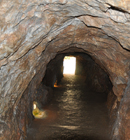
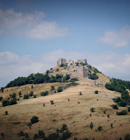
Today we will be exploring the Eastern part of Kosovo. We start with a walk to the Ethnographic Museum situated in a typical house of Ottoman architecture beautifully stocked with artefacts which testify to the traditions and way of living of the people in Kosovo. At Gracanica we visit the superb 14th century Orthodox Church founded by the Serbian king Stefan Milutin in 1321, a triumph of Byzantine architecture and part of the Kosovo Medieval Monuments protected by UNESCO. Close by lay the remains of ancient Ulpiana the capital of the roman province of Dardania, a place earlier settled by the Illyrian tribe of Dardanoi where it took its name from. It flourished under roman rule and after being destroyed by an earthquake it was built under the cure of Emperor Justinian and started to be known as Justiniana Secunda. Continue on toward Novoberda to visit its panoramically standing medieval castle which protected the mines of gold, silver and other metals found close by. Letnica is a village formally home to a Croatian minority in Kosovo, famous for its white washed church and a 400 years old blackened wood statue of the Virgin Mary, carved in the style of Michelangelo, known as “Black Madonna”. It is said to be one of very few Black Madonna’s found around the world. It is also the place that perhaps convinced Mother Theresa to become a missionary, on a pilgrimage to the Letnica church during the festival of the “Black Madonna” back in 1928. After the visits return to Pristina with a stop at the Gadima cave which is 1200 meter long, also known as the Marble cave due its marble like colors full of crystallized stalagmites. Visit of the cave and return to Pristina for overnight.
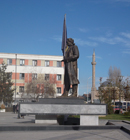
After breakfast we visit two Ottoman period mosques of Pristina with probably the most beautiful, being the Fatih Mosque dating back to 1461 during the golden rule of Sultan Mehmet II. Its huge ceiling domed cupola crowns a splendidly painted floral interior of Arabesque design. Nearby is Pristina's oldest building, the Çarshia Mosque completed in 1389. After these visits depart to airport.
395 Euro per person sharing a double or twin room for minimum 6 participants
490 Euro per person sharing a double or twin room for minimum 4 participants
650 Euro per person sharing a double or twin room for minimum 2 participants
Single supplement = 80 Euro. (Single rooms will usually be double or twin for single use.)
Includes:
March, April, May, June, September, October, November